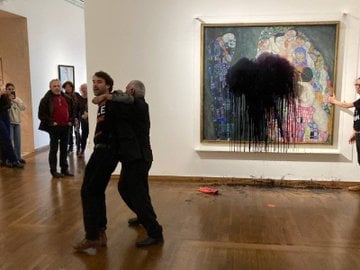An eco-terrorist cult that calls itself Letzte Generation Österreich (Last Generation Austria) filmed an attack by cult members on a painting in the Leopold Museum in Vienna on Tuesday in protest of life-saving fossil fuels. The painting was displayed with a clear protective barrier. A male cult member was seen smearing what appears to be black oil on the protective barrier over the painting Death and Life by Gustav Klimt while another male cult member glued his hand to the barrier. A museum staff member intervened in the attack, restraining the man who smeared the painting.
This is the latest attack on art by eco-terrorist cult members who have attacked paintings in museums in England, Germany, Italy and Australia.
Last Generation Austria photos and video of the attack:
“URGE: Klimt’s “Death and Life” in the Leopold Museum covered in oil. People of the last generation poured oil on the Klimt painting “Death and Life” in the Leopold Museum today. New oil and gas wells are a death sentence for humanity.”
“We need immediate measures against #ClimateBreakdown NOW. Lowering the speed limit to 100km/h on highways costs nothing to implement, saves 460 million tons of CO2 per year in #Austria alone and leads to less noise, better air quality and safer roads. What are we waiting for?”
Excerpts from report by the Austria Press Agency via translation:
…While the restoration team gave the all-clear regarding the picture, the damage to the glass and safety frame, as well as the wall and floor, was “evident and significant.” Hans-Peter Wipplinger, director of the Leopold Museum, described the concerns of the climate activists as justified, “but the attack on works of art is definitely the wrong way to achieve the targeted goal of preventing the predicted climate collapse”. Museums are preserving institutions and a prime example of sustainability. He appealed to the “last generation” to find other ways of making their concerns known.
On the occasion of the Leopoldi Day, there was free entry to the Leopold Museum, and OMV acted as a sponsor in this context. Despite precise controls – for example, bags had to be handed in – the activists smuggled the liquid into the museum in a hot-water bottle under their clothing. The police and rescue services were on site in a very short time and recorded the data of the activists, according to a museum broadcast.
The Austrian Museums Association has meanwhile sent an open letter to the members of the “Last Generation”: The museums in Austria would endeavor to “make a public contribution to the discourse on changes to our planet and our livelihoods caused by human intervention and their negative effects on the climate, nature and its diversity”. One is therefore also available as a discussion and cooperation partner for concerns of climate protection. At the same time, an appeal was made to climate activists to refrain from doing anything “that endangers the preservation of natural and cultural heritage and also the role of museums as places of education and learning”…
The Leopold Museum description of the painting:
GUSTAV KLIMT, DEATH AND LIFE1910/15
As one of Gustav Klimt’s central works, this is regarded as one of his greatest allegories, in which he used a bold composition to address the cycle of human life. His first sketches on paper were made as early as 1908 and were brought to oil in 1910. In its first presentation at the 1911 International Art Exhibition in Rome, Klimt received the gold medal. For unknown reasons, he decided to fundamentally revision the work in 1915. Klimt was able to depict the jarring entanglement of life and death through the formal and motivic contrast of a stream of naked human bodies – mother and child, an old woman, a loving couple – surrounded by colorful ornaments and flowers on the right, and the solitary, darkly dressed figure of death on the left. What was supposed to have originally been a gold background appears in the final version as gray, with death appearing almost vigorous, wrapped in a blue ornamental coat and raising a small red club, while life glows with its bright colors, figures, and ornamentation.




